- Doctor: Younger Ebola patients have a greater chance of survival
- The amount of viral load a victim contracts could affect how sick he or she gets
- The ability to rehydrate patients in critical
(CNN) -- For a disease that kills more than half of its victims abroad, Ebola in the United States is getting snuffed out at a remarkably fast rate.
When Dr. Kent Brantly became the first U.S. patient with Ebola in August, he was hospitalized for 19 days.
On Tuesday, when nurse Amber Vinson became the most recent American patient discharged, she was hospitalized for just 14 days.
 Quarantined American: I'm in disbelief
Quarantined American: I'm in disbelief  U.S. troops ordered into Ebola quarantine
U.S. troops ordered into Ebola quarantine 
 Amber Vinson, one of the two Dallas nurses who were diagnosed with Ebola, embraces Emory University Hospital epidemiologist Dr. Bruce Ribner after being discharged from the Atlanta hospital on Tuesday, October 28. Vinson and the other nurse, Nina Pham, have both been declared Ebola-free.
Amber Vinson, one of the two Dallas nurses who were diagnosed with Ebola, embraces Emory University Hospital epidemiologist Dr. Bruce Ribner after being discharged from the Atlanta hospital on Tuesday, October 28. Vinson and the other nurse, Nina Pham, have both been declared Ebola-free.  Kaci Hickox, who recently returned to the United States after working in Ebola-ravaged West Africa, sent CNN this image of the tent where she was being isolated for Ebola monitoring Sunday, October 26, in New Jersey. Hospital officials told CNN the indoor tent is in a climate-controlled extended-care facility adjacent to a hospital. Hickox was eventually discharged after testing negative for Ebola twice.
Kaci Hickox, who recently returned to the United States after working in Ebola-ravaged West Africa, sent CNN this image of the tent where she was being isolated for Ebola monitoring Sunday, October 26, in New Jersey. Hospital officials told CNN the indoor tent is in a climate-controlled extended-care facility adjacent to a hospital. Hickox was eventually discharged after testing negative for Ebola twice. 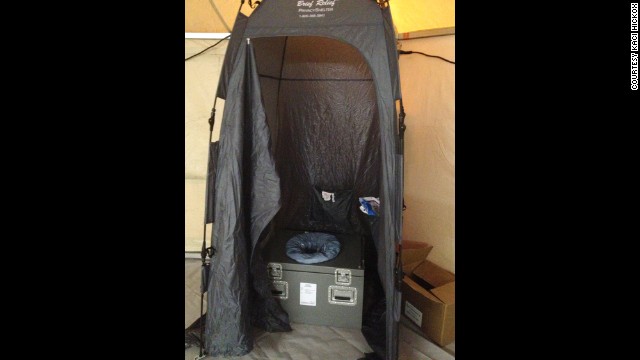 Hickox also sent this image of the toilet facilities in the tent.
Hickox also sent this image of the toilet facilities in the tent.  U.S. President Barack Obama hugs Ebola survivor Nina Pham in the Oval Office of the White House on Friday, October 24. Pham, one of the two Dallas nurses who were diagnosed with the virus, was declared Ebola-free after being treated at a hospital in Bethesda, Maryland.
U.S. President Barack Obama hugs Ebola survivor Nina Pham in the Oval Office of the White House on Friday, October 24. Pham, one of the two Dallas nurses who were diagnosed with the virus, was declared Ebola-free after being treated at a hospital in Bethesda, Maryland.  Police officers on Thursday, October 23, stand outside the New York City apartment of Craig Spencer, a Doctors Without Borders physician who recently returned from West Africa and tested positive for Ebola. Health officials say the Ebola outbreak in West Africa is the deadliest ever. More than 4,800 people have died there, according to the World Health Organization.
Police officers on Thursday, October 23, stand outside the New York City apartment of Craig Spencer, a Doctors Without Borders physician who recently returned from West Africa and tested positive for Ebola. Health officials say the Ebola outbreak in West Africa is the deadliest ever. More than 4,800 people have died there, according to the World Health Organization.  Health workers in Port Loko, Sierra Leone, transport the body of a person who is suspected to have died of Ebola on Tuesday, October 21.
Health workers in Port Loko, Sierra Leone, transport the body of a person who is suspected to have died of Ebola on Tuesday, October 21.  RoseAnn DeMoro, executive director of the California Nurses Association and National Nurses United, talks to reporters in Sacramento, California, after meeting with Gov. Jerry Brown to discuss the Ebola crisis on October 21.
RoseAnn DeMoro, executive director of the California Nurses Association and National Nurses United, talks to reporters in Sacramento, California, after meeting with Gov. Jerry Brown to discuss the Ebola crisis on October 21.  Health workers bury a body on the outskirts of Monrovia, Liberia, on Monday, October 20.
Health workers bury a body on the outskirts of Monrovia, Liberia, on Monday, October 20.  Christine Wade, a registered nurse at the University of Texas Medical Branch, greets Carnival Magic passengers disembarking in Galveston, Texas, on Sunday, October 19. Nurses met passengers with Ebola virus fact sheets and were available to answer any questions. A Dallas health care worker was in voluntary isolation aboard the cruise ship because of her potential contact with the Ebola virus. She had shown no signs of the disease, however.
Christine Wade, a registered nurse at the University of Texas Medical Branch, greets Carnival Magic passengers disembarking in Galveston, Texas, on Sunday, October 19. Nurses met passengers with Ebola virus fact sheets and were available to answer any questions. A Dallas health care worker was in voluntary isolation aboard the cruise ship because of her potential contact with the Ebola virus. She had shown no signs of the disease, however.  Garteh Korkoryah, center, is comforted during a memorial service for her son, Thomas Eric Duncan, on Saturday, October 18, in Salisbury, North Carolina. Duncan, a 42-year-old Liberian citizen, died October 8 in a Dallas hospital. He was in the country to visit his son and his son's mother, and he was the first person in the United States to be diagnosed with Ebola.
Garteh Korkoryah, center, is comforted during a memorial service for her son, Thomas Eric Duncan, on Saturday, October 18, in Salisbury, North Carolina. Duncan, a 42-year-old Liberian citizen, died October 8 in a Dallas hospital. He was in the country to visit his son and his son's mother, and he was the first person in the United States to be diagnosed with Ebola.  An airplane carrying Nina Pham arrives at an airport in Frederick, Maryland, on Thursday, October 16. Pham is one of the two nurses who were diagnosed with Ebola after treating Duncan. Pham was sent to Maryland to be treated at a National Institutes of Health hospital, and she was declared Ebola-free several days later.
An airplane carrying Nina Pham arrives at an airport in Frederick, Maryland, on Thursday, October 16. Pham is one of the two nurses who were diagnosed with Ebola after treating Duncan. Pham was sent to Maryland to be treated at a National Institutes of Health hospital, and she was declared Ebola-free several days later.  Boys run from blowing dust as a U.S. military aircraft leaves the construction site of an Ebola treatment center in Tubmanburg, Liberia, on Wednesday, October 15.
Boys run from blowing dust as a U.S. military aircraft leaves the construction site of an Ebola treatment center in Tubmanburg, Liberia, on Wednesday, October 15.  Aid workers from the Liberian Medical Renaissance League stage an Ebola awareness event October 15 in Monrovia. The group performs street dramas throughout Monrovia to educate the public on Ebola symptoms and how to handle people who are infected with the virus.
Aid workers from the Liberian Medical Renaissance League stage an Ebola awareness event October 15 in Monrovia. The group performs street dramas throughout Monrovia to educate the public on Ebola symptoms and how to handle people who are infected with the virus.  U.S. President Barack Obama speaks to the media about Ebola during a meeting in the Cabinet Room of the White House on October 15. Obama said his administration will respond to new Ebola cases "in a much more aggressive way," taking charge of the issue after the second Texas nurse was diagnosed with the disease.
U.S. President Barack Obama speaks to the media about Ebola during a meeting in the Cabinet Room of the White House on October 15. Obama said his administration will respond to new Ebola cases "in a much more aggressive way," taking charge of the issue after the second Texas nurse was diagnosed with the disease.  A U.S. Marine looks out from an MV-22 Osprey aircraft before landing at the site of an Ebola treatment center under construction in Tubmanburg on October 15. It is the first of 17 Ebola treatment centers to be built by Liberian army soldiers and American troops as part of the U.S. response to the epidemic.
A U.S. Marine looks out from an MV-22 Osprey aircraft before landing at the site of an Ebola treatment center under construction in Tubmanburg on October 15. It is the first of 17 Ebola treatment centers to be built by Liberian army soldiers and American troops as part of the U.S. response to the epidemic.  A man dressed in protective clothing treats the front porch of a Dallas apartment where one of the infected nurses resides on Sunday, October 12.
A man dressed in protective clothing treats the front porch of a Dallas apartment where one of the infected nurses resides on Sunday, October 12. 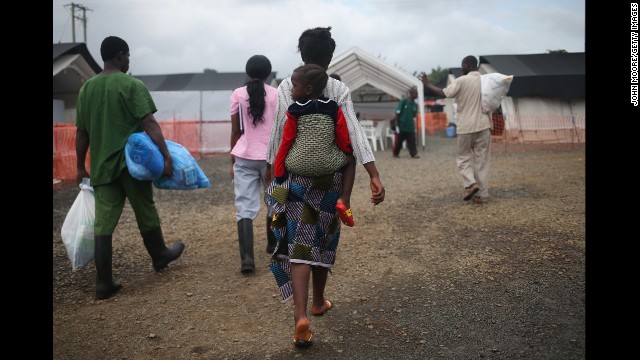 Ebola survivors prepare to leave a Doctors Without Borders treatment center after recovering from the virus in Paynesville, Liberia, on October 12.
Ebola survivors prepare to leave a Doctors Without Borders treatment center after recovering from the virus in Paynesville, Liberia, on October 12.  A member of the Liberian army stands near a U.S. aircraft Saturday, October 11, in Tubmanburg.
A member of the Liberian army stands near a U.S. aircraft Saturday, October 11, in Tubmanburg.  A woman crawls toward the body of her sister as a burial team takes her away for cremation Friday, October 10, in Monrovia. The sister had died from Ebola earlier in the morning while trying to walk to a treatment center, according to her relatives.
A woman crawls toward the body of her sister as a burial team takes her away for cremation Friday, October 10, in Monrovia. The sister had died from Ebola earlier in the morning while trying to walk to a treatment center, according to her relatives.  Ebola survivor Joseph Yensy prepares to be discharged from the Doctors Without Borders treatment center in Paynesville, Liberia, on Sunday, October 5.
Ebola survivor Joseph Yensy prepares to be discharged from the Doctors Without Borders treatment center in Paynesville, Liberia, on Sunday, October 5.  Sanitized boots dry at the Doctors Without Borders treatment center in Paynesville on October 5.
Sanitized boots dry at the Doctors Without Borders treatment center in Paynesville on October 5.  Residents of an Ebola-affected township take home kits distributed by Doctors Without Borders on Saturday, October 4, in New Kru Town, Liberia. The kits, which include buckets, soap, gloves, anti-contamination gowns, plastic bags, a spray bottle and masks, are meant to give people some level of protection if a family member becomes sick.
Residents of an Ebola-affected township take home kits distributed by Doctors Without Borders on Saturday, October 4, in New Kru Town, Liberia. The kits, which include buckets, soap, gloves, anti-contamination gowns, plastic bags, a spray bottle and masks, are meant to give people some level of protection if a family member becomes sick.  A person peeks out from the Dallas apartment where Thomas Eric Duncan, the first person diagnosed with the Ebola virus in the United States, was staying on Friday, October 3.
A person peeks out from the Dallas apartment where Thomas Eric Duncan, the first person diagnosed with the Ebola virus in the United States, was staying on Friday, October 3. 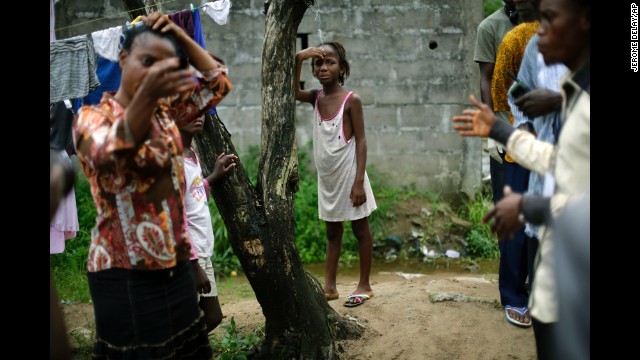 A girl cries as community activists approach her outside her Monrovia home on Thursday, October 2, a day after her mother was taken to an Ebola ward.
A girl cries as community activists approach her outside her Monrovia home on Thursday, October 2, a day after her mother was taken to an Ebola ward. 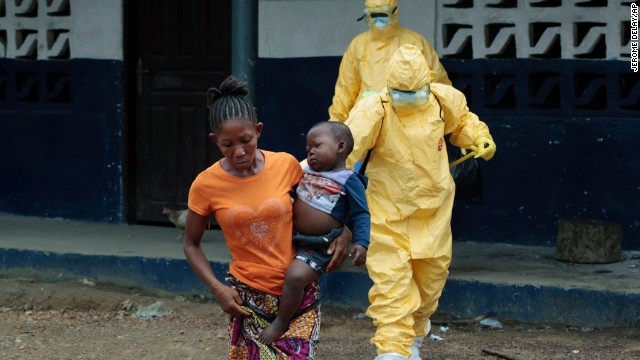 Marie Nyan, whose mother died of Ebola, carries her 2-year-old son, Nathaniel Edward, to an ambulance in the Liberian village of Freeman Reserve on Tuesday, September 30.
Marie Nyan, whose mother died of Ebola, carries her 2-year-old son, Nathaniel Edward, to an ambulance in the Liberian village of Freeman Reserve on Tuesday, September 30.  A health official uses a thermometer Monday, September 29, to screen a Ukrainian crew member on the deck of a cargo ship at the Apapa port in Lagos, Nigeria.
A health official uses a thermometer Monday, September 29, to screen a Ukrainian crew member on the deck of a cargo ship at the Apapa port in Lagos, Nigeria.  Children pray during Sunday service at the Bridgeway Baptist Church in Monrovia on Sunday, September 28.
Children pray during Sunday service at the Bridgeway Baptist Church in Monrovia on Sunday, September 28.  Residents of the St. Paul Bridge neighborhood in Monrovia take a man suspected of having Ebola to a clinic on September 28.
Residents of the St. Paul Bridge neighborhood in Monrovia take a man suspected of having Ebola to a clinic on September 28.  Workers move a building into place as part of a new Ebola treatment center in Monrovia on September 28.
Workers move a building into place as part of a new Ebola treatment center in Monrovia on September 28. 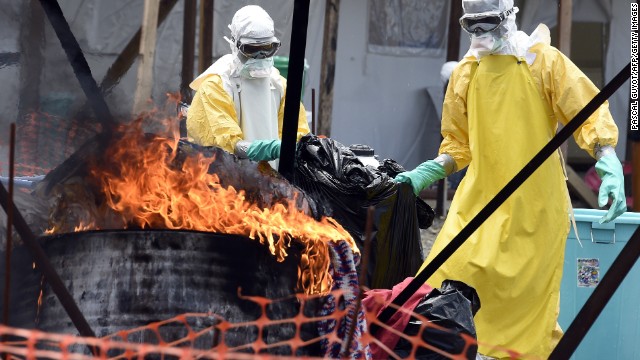 Medical staff members at the Doctors Without Borders facility in Monrovia burn clothes belonging to Ebola patients on Saturday, September 27.
Medical staff members at the Doctors Without Borders facility in Monrovia burn clothes belonging to Ebola patients on Saturday, September 27. 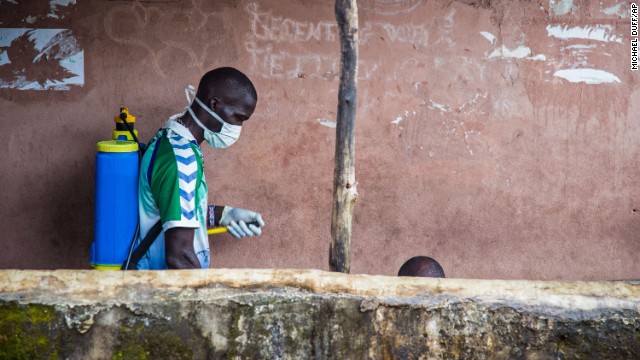 A health worker in Freetown, Sierra Leone, sprays disinfectant around the area where a man sits before loading him into an ambulance on Wednesday, September 24.
A health worker in Freetown, Sierra Leone, sprays disinfectant around the area where a man sits before loading him into an ambulance on Wednesday, September 24. 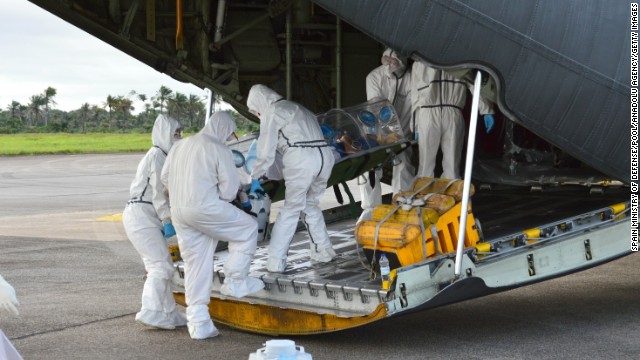 Medics load an Ebola patient onto a plane at Sierra Leone's Freetown-Lungi International Airport on Monday, September 22.
Medics load an Ebola patient onto a plane at Sierra Leone's Freetown-Lungi International Airport on Monday, September 22.  A few people are seen in Freetown during a three-day nationwide lockdown on Sunday, September 21. In an attempt to curb the spread of the Ebola virus, people in Sierra Leone were told to stay in their homes.
A few people are seen in Freetown during a three-day nationwide lockdown on Sunday, September 21. In an attempt to curb the spread of the Ebola virus, people in Sierra Leone were told to stay in their homes.  Supplies wait to be loaded onto an aircraft at New York's John F. Kennedy International Airport on Saturday, September 20. It was the largest single shipment of aid to the Ebola zone to date, and it was coordinated by the Clinton Global Initiative and other U.S. aid organizations.
Supplies wait to be loaded onto an aircraft at New York's John F. Kennedy International Airport on Saturday, September 20. It was the largest single shipment of aid to the Ebola zone to date, and it was coordinated by the Clinton Global Initiative and other U.S. aid organizations. 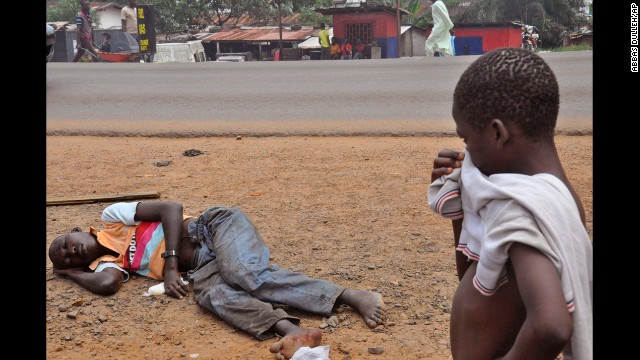 A child stops on a Monrovia street Friday, September 12, to look at a man who is suspected of suffering from Ebola.
A child stops on a Monrovia street Friday, September 12, to look at a man who is suspected of suffering from Ebola. 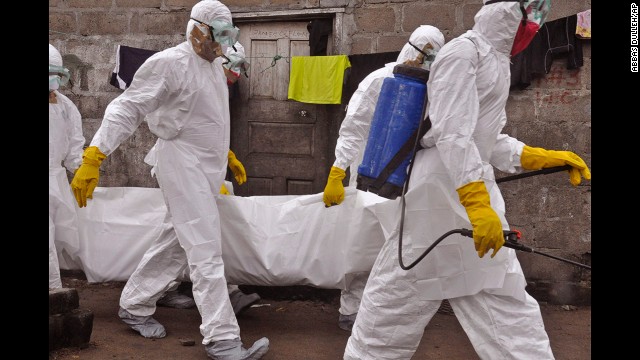 Health workers on Wednesday, September 10, carry the body of a woman who they suspect died from the Ebola virus in Monrovia.
Health workers on Wednesday, September 10, carry the body of a woman who they suspect died from the Ebola virus in Monrovia. 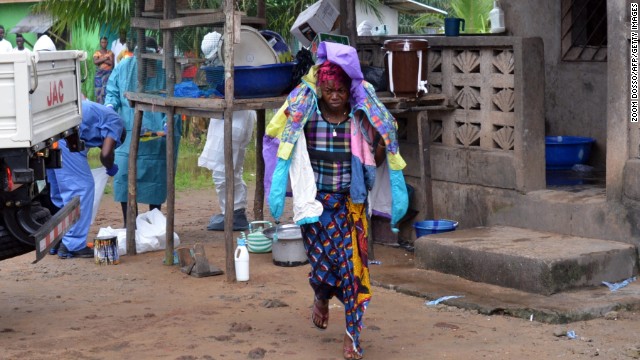 A woman in Monrovia carries the belongings of her husband, who died after he was infected by the Ebola virus.
A woman in Monrovia carries the belongings of her husband, who died after he was infected by the Ebola virus.  Health workers in Monrovia place a corpse into a body bag on Thursday, September 4.
Health workers in Monrovia place a corpse into a body bag on Thursday, September 4.  After an Ebola case was confirmed in Senegal, people load cars with household items as they prepare to cross into Guinea from the border town of Diaobe, Senegal, on Wednesday, September 3.
After an Ebola case was confirmed in Senegal, people load cars with household items as they prepare to cross into Guinea from the border town of Diaobe, Senegal, on Wednesday, September 3.  Crowds cheer and celebrate in the streets Saturday, August 30, after Liberian authorities reopened the West Point slum in Monrovia. The military had been enforcing a quarantine on West Point, fearing a spread of the Ebola virus.
Crowds cheer and celebrate in the streets Saturday, August 30, after Liberian authorities reopened the West Point slum in Monrovia. The military had been enforcing a quarantine on West Point, fearing a spread of the Ebola virus.  A health worker wearing a protective suit conducts an Ebola prevention drill at the port in Monrovia on Friday, August 29.
A health worker wearing a protective suit conducts an Ebola prevention drill at the port in Monrovia on Friday, August 29.  Volunteers working with the bodies of Ebola victims in Kenema, Sierra Leone, sterilize their uniforms on Sunday, August 24.
Volunteers working with the bodies of Ebola victims in Kenema, Sierra Leone, sterilize their uniforms on Sunday, August 24.  A guard stands at a checkpoint Saturday, August 23, between the quarantined cities of Kenema and Kailahun in Sierra Leone.
A guard stands at a checkpoint Saturday, August 23, between the quarantined cities of Kenema and Kailahun in Sierra Leone.  A burial team from the Liberian Ministry of Health unloads bodies of Ebola victims onto a funeral pyre at a crematorium in Marshall, Liberia, on Friday, August 22.
A burial team from the Liberian Ministry of Health unloads bodies of Ebola victims onto a funeral pyre at a crematorium in Marshall, Liberia, on Friday, August 22.  Dr. Kent Brantly leaves Emory University Hospital on Thursday, August 21, after being declared no longer infectious from the Ebola virus. Brantly was one of two American missionaries brought to Emory for treatment of the deadly virus.
Dr. Kent Brantly leaves Emory University Hospital on Thursday, August 21, after being declared no longer infectious from the Ebola virus. Brantly was one of two American missionaries brought to Emory for treatment of the deadly virus.  Family members of West Point district commissioner Miata Flowers flee the slum in Monrovia while being escorted by the Ebola Task Force on Wednesday, August 20.
Family members of West Point district commissioner Miata Flowers flee the slum in Monrovia while being escorted by the Ebola Task Force on Wednesday, August 20.  An Ebola Task Force soldier beats a local resident while enforcing a quarantine on the West Point slum on August 20.
An Ebola Task Force soldier beats a local resident while enforcing a quarantine on the West Point slum on August 20.  Local residents gather around a very sick Saah Exco, 10, in a back alley of the West Point slum on Tuesday, August 19. The boy was one of the patients that was pulled out of a holding center for suspected Ebola patients after the facility was overrun and closed by a mob on August 16. A local clinic then refused to treat Saah, according to residents, because of the danger of infection. Although he was never tested for Ebola, Saah's mother and brother died in the holding center.
Local residents gather around a very sick Saah Exco, 10, in a back alley of the West Point slum on Tuesday, August 19. The boy was one of the patients that was pulled out of a holding center for suspected Ebola patients after the facility was overrun and closed by a mob on August 16. A local clinic then refused to treat Saah, according to residents, because of the danger of infection. Although he was never tested for Ebola, Saah's mother and brother died in the holding center.  A burial team wearing protective clothing retrieves the body of a 60-year-old Ebola victim from his home near Monrovia on Sunday, August 17.
A burial team wearing protective clothing retrieves the body of a 60-year-old Ebola victim from his home near Monrovia on Sunday, August 17.  lija Siafa, 6, stands in the rain with his 10-year-old sister, Josephine, while waiting outside Doctors Without Borders' Ebola treatment center in Monrovia on August 17. The newly built facility will initially have 120 beds, making it the largest-ever facility for Ebola treatment and isolation.
lija Siafa, 6, stands in the rain with his 10-year-old sister, Josephine, while waiting outside Doctors Without Borders' Ebola treatment center in Monrovia on August 17. The newly built facility will initially have 120 beds, making it the largest-ever facility for Ebola treatment and isolation.  Brett Adamson, a staff member from Doctors Without Borders, hands out water to sick Liberians hoping to enter the new Ebola treatment center on August 17.
Brett Adamson, a staff member from Doctors Without Borders, hands out water to sick Liberians hoping to enter the new Ebola treatment center on August 17.  Workers prepare the new Ebola treatment center on August 17.
Workers prepare the new Ebola treatment center on August 17.  A body, reportedly a victim of Ebola, lies on a street corner in Monrovia on Saturday, August 16.
A body, reportedly a victim of Ebola, lies on a street corner in Monrovia on Saturday, August 16.  Liberian police depart after firing shots in the air while trying to protect an Ebola burial team in the West Point slum of Monrovia on August 16. A crowd of several hundred local residents reportedly drove away the burial team and their police escort. The mob then forced open an Ebola isolation ward and took patients out, saying the Ebola epidemic is a hoax.
Liberian police depart after firing shots in the air while trying to protect an Ebola burial team in the West Point slum of Monrovia on August 16. A crowd of several hundred local residents reportedly drove away the burial team and their police escort. The mob then forced open an Ebola isolation ward and took patients out, saying the Ebola epidemic is a hoax.  A crowd enters the grounds of an Ebola isolation center in the West Point slum on August 16. The mob was reportedly shouting, "No Ebola in West Point."
A crowd enters the grounds of an Ebola isolation center in the West Point slum on August 16. The mob was reportedly shouting, "No Ebola in West Point."  A health worker disinfects a corpse after a man died in a classroom being used as an Ebola isolation ward Friday, August 15, in Monrovia.
A health worker disinfects a corpse after a man died in a classroom being used as an Ebola isolation ward Friday, August 15, in Monrovia.  A boy tries to prepare his father before they are taken to an Ebola isolation ward August 15 in Monrovia.
A boy tries to prepare his father before they are taken to an Ebola isolation ward August 15 in Monrovia.  Kenyan health officials take passengers' temperature as they arrive at the Jomo Kenyatta International Airport on Thursday, August 14, in Nairobi, Kenya.
Kenyan health officials take passengers' temperature as they arrive at the Jomo Kenyatta International Airport on Thursday, August 14, in Nairobi, Kenya.  A hearse carries the coffin of Spanish priest Miguel Pajares after he died at a Madrid hospital on Tuesday, August 12. Pajares, 75, contracted Ebola while he was working as a missionary in Liberia.
A hearse carries the coffin of Spanish priest Miguel Pajares after he died at a Madrid hospital on Tuesday, August 12. Pajares, 75, contracted Ebola while he was working as a missionary in Liberia.  Health workers in Kenema screen people for the Ebola virus on Saturday, August 9, before they enter the Kenema Government Hospital.
Health workers in Kenema screen people for the Ebola virus on Saturday, August 9, before they enter the Kenema Government Hospital.  Paramedics in protective suits move Pajares, the infected Spanish priest, at Carlos III Hospital in Madrid on Thursday, August 7. He died five days later.
Paramedics in protective suits move Pajares, the infected Spanish priest, at Carlos III Hospital in Madrid on Thursday, August 7. He died five days later.  Nurses carry the body of an Ebola victim from a house outside Monrovia on Wednesday, August 6.
Nurses carry the body of an Ebola victim from a house outside Monrovia on Wednesday, August 6.  A Nigerian health official wears protective gear August 6 at Murtala Muhammed International Airport in Lagos.
A Nigerian health official wears protective gear August 6 at Murtala Muhammed International Airport in Lagos. 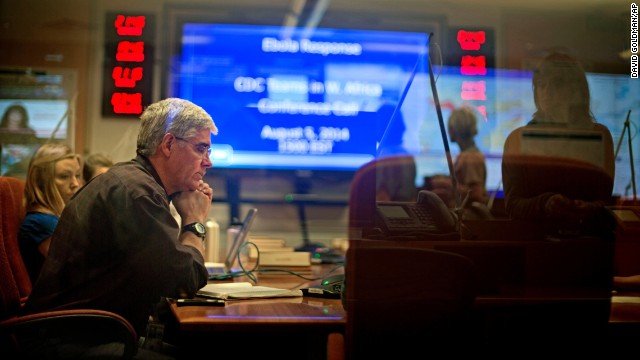 Officials with the Centers for Disease Control and Prevention in Atlanta sit in on a conference call about Ebola with CDC team members deployed in West Africa on Tuesday, August 5.
Officials with the Centers for Disease Control and Prevention in Atlanta sit in on a conference call about Ebola with CDC team members deployed in West Africa on Tuesday, August 5.  Aid worker Nancy Writebol, wearing a protective suit, gets wheeled on a gurney into Emory University Hospital in Atlanta on August 5. A medical plane flew Writebol from Liberia to the United States after she and her colleague Dr. Kent Brantly were infected with the Ebola virus in the West African country.
Aid worker Nancy Writebol, wearing a protective suit, gets wheeled on a gurney into Emory University Hospital in Atlanta on August 5. A medical plane flew Writebol from Liberia to the United States after she and her colleague Dr. Kent Brantly were infected with the Ebola virus in the West African country.  Nigerian health officials are on hand to screen passengers at Murtala Muhammed International Airport on Monday, August 4.
Nigerian health officials are on hand to screen passengers at Murtala Muhammed International Airport on Monday, August 4.  Nurses wearing protective clothing are sprayed with disinfectant Friday, August 1, in Monrovia after they prepared the bodies of Ebola victims for burial.
Nurses wearing protective clothing are sprayed with disinfectant Friday, August 1, in Monrovia after they prepared the bodies of Ebola victims for burial.  A nurse disinfects the waiting area at the ELWA Hospital in Monrovia on Monday, July 28.
A nurse disinfects the waiting area at the ELWA Hospital in Monrovia on Monday, July 28.  In this photo provided by Samaritan's Purse, Dr. Kent Brantly, left, treats an Ebola patient in Monrovia. On July 26, the North Carolina-based group said Brantly tested positive for the disease. Days later, Brantly arrived in Georgia to be treated at an Atlanta hospital, becoming the first Ebola patient to knowingly be treated in the United States.
In this photo provided by Samaritan's Purse, Dr. Kent Brantly, left, treats an Ebola patient in Monrovia. On July 26, the North Carolina-based group said Brantly tested positive for the disease. Days later, Brantly arrived in Georgia to be treated at an Atlanta hospital, becoming the first Ebola patient to knowingly be treated in the United States. 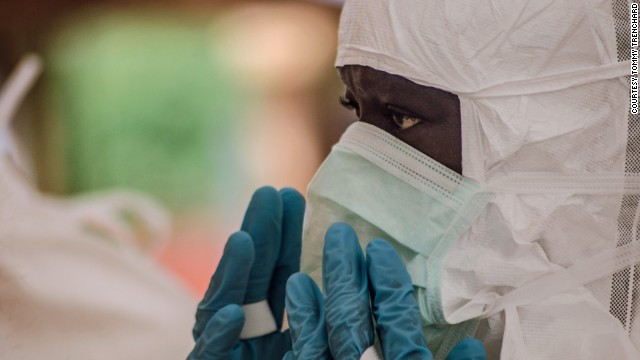 A doctor puts on protective gear at the treatment center in Kailahun on Sunday, July 20.
A doctor puts on protective gear at the treatment center in Kailahun on Sunday, July 20.  Members of Doctors Without Borders adjust tents in the isolation area in Kailahun on July 20.
Members of Doctors Without Borders adjust tents in the isolation area in Kailahun on July 20. 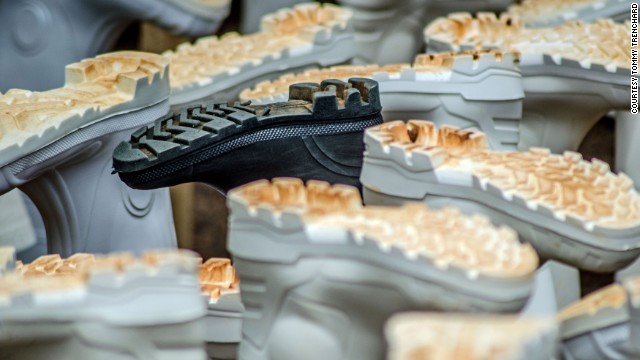 Boots dry in the Ebola treatment center in Kailahun on July 20.
Boots dry in the Ebola treatment center in Kailahun on July 20.  Dr. Jose Rovira of the World Health Organization takes a swab from a suspected Ebola victim in Pendembu, Sierra Leone, on Friday, July 18.
Dr. Jose Rovira of the World Health Organization takes a swab from a suspected Ebola victim in Pendembu, Sierra Leone, on Friday, July 18.  Red Cross volunteers disinfect each other with chlorine after removing the body of an Ebola victim from a house in Pendembu on July 18.
Red Cross volunteers disinfect each other with chlorine after removing the body of an Ebola victim from a house in Pendembu on July 18.  A doctor works in the field laboratory at the Ebola treatment center in Kailahun on Thursday, July 17.
A doctor works in the field laboratory at the Ebola treatment center in Kailahun on Thursday, July 17.  Doctors Without Borders staff prepare to enter the isolation ward at an Ebola treatment center in Kailahun on July 17.
Doctors Without Borders staff prepare to enter the isolation ward at an Ebola treatment center in Kailahun on July 17.  Dr. Mohamed Vandi of the Kenema Government Hospital trains community volunteers who will aim to educate people about Ebola in Sierra Leone.
Dr. Mohamed Vandi of the Kenema Government Hospital trains community volunteers who will aim to educate people about Ebola in Sierra Leone.  A woman has her temperature taken at a screening checkpoint on the road out of Kenema on Wednesday, July 9.
A woman has her temperature taken at a screening checkpoint on the road out of Kenema on Wednesday, July 9.  A member of Doctors Without Borders puts on protective gear at the isolation ward of the Donka Hospital in Conakry on Saturday, June 28.
A member of Doctors Without Borders puts on protective gear at the isolation ward of the Donka Hospital in Conakry on Saturday, June 28.  Airport employees check passengers in Conakry before they leave the country on Thursday, April 10.
Airport employees check passengers in Conakry before they leave the country on Thursday, April 10.  A Guinea-Bissau customs official watches arrivals from Conakry on Tuesday, April 8.
A Guinea-Bissau customs official watches arrivals from Conakry on Tuesday, April 8.  Egidia Almeida, a nurse in Guinea-Bissau, scans a Guinean citizen coming from Conakry on April 8.
Egidia Almeida, a nurse in Guinea-Bissau, scans a Guinean citizen coming from Conakry on April 8.  A scientist separates blood cells from plasma cells to isolate any Ebola RNA and test for the virus Thursday, April 3, at the European Mobile Laboratory in Gueckedou, Guinea.
A scientist separates blood cells from plasma cells to isolate any Ebola RNA and test for the virus Thursday, April 3, at the European Mobile Laboratory in Gueckedou, Guinea. 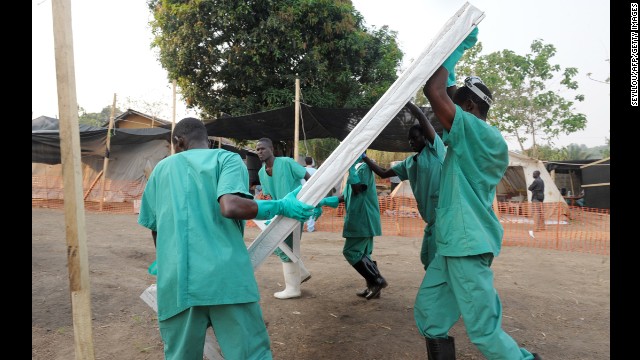 Health specialists work Monday, March 31, at an isolation ward for patients at the facility in southern Guinea.
Health specialists work Monday, March 31, at an isolation ward for patients at the facility in southern Guinea.  Photos: The Ebola epidemic
Photos: The Ebola epidemic Her colleague, Nina Pham, also went home after just 14 days.
"So the question is, why did our patient recover so quickly?" said Dr. Bruce Ribner of Emory University Hospital in Atlanta, where Vinson was treated.
"The honest answer is we're not exactly sure."
But he and other health experts have several hypotheses:
Younger patients recover faster
Vinson, 29, and Pham, 26, were among the youngest patients treated in the developed world.
"We know from a lot of data coming out Africa that younger patients do much better than patients who are older," Ribner said.
But unlike West Africa, where Ebola has killed close to 5,000 people, Americans have the advantage of better nutrition. If an infected patient getting proper care normally has a strong immune system -- and younger patients generally do -- the chance of survival goes up.
The virus was aggressively attacked
"The general dogma in our industry in July was that if patients got so ill that they required dialysis or ventilator support there was no purpose in doing those interventions because they would invariably die," Ribner said.
"I think we have changed the algorithm for how aggressive we can be in caring for patients with Ebola virus."
Of the nine Ebola patients treated at U.S. hospitals, eight have survived. And all of those released have something in common -- they were treated at one of the country's four hospitals that have been preparing for years to treat a highly infectious disease like Ebola.
The sole fatality in the United States -- Thomas Eric Duncan -- was not treated at one of those facilities.
 Fmr. U.S. surgeon general on Ebola
Fmr. U.S. surgeon general on Ebola  States take Ebola crisis into their hands
States take Ebola crisis into their hands  'Mandatory quarantines do not work'
'Mandatory quarantines do not work' Speed matters
This may seem obvious. But sometimes it's the basics -- namely, the ability to pump ample fluids through patients with severe diarrhea and vomiting -- that can mean the difference between life and death.
"The most important care of patients with Ebola is to manage their fluids and electrolytes, to make sure that they don't get dehydrated," said Dr. Tom Frieden, director of the Centers for Disease Control and Prevention. "And that requires some meticulous attention to detail and aggressive rehydration in many cases."
When he first arrived at Texas Health Presbyterian Dallas Hospital, Duncan was sent home with antibiotics. He wasn't admitted for another three days.
Brantly, Writebol and Dr. Rick Sacra became symptomatic while they were still in Liberia -- and they had to be flown here, spurring a slight delay in treatment.
Most others were quickly tested and quarantined as soon as a low-grade fever was detected.
Transfusions may have helped
Most of the American patients received blood or plasma transfusions from other survivors. The plasma contains antibodies that could fight the virus in others.
Brantly donated plasma to at least three patients -- Pham, Sacra and NBC freelance cameraman Ashoka Mukpo. All three survived.
"It's very fortunate that the three patients I've been able to donate to, they and I share the same blood type," Brantly told CNN's Anderson Cooper.
There was some controversy about why Brantly didn't give plasma to Duncan, who eventually died. But health officials said the two did not have the same blood type.
Dr. Craig Spencer, the only Ebola patient still being treated at a U.S. hospital, recently received a transfusion from Nancy Writebol, one of the first American survivors.
Experimental drugs may have helped, too
Duncan received experimental medicine six days after admission to the hospital. It was a far longer wait than four other Ebola patients treated in the United States. Those patients got experimental medicine immediately.
Experts, however, say the jury's out on the effectiveness of these drugs.
Protective wear reduces exposure
The relatively swift recoveries of Vinson and Pham might also be attributed to their personal protective equipment (PPE) they were wearing when they treated Duncan.
While some nurses at the Texas hospital reportedly complained about PPE that left their necks exposed, at least Vinson was suited up.
"She was wearing personal protective equipment during the care of her patient in Dallas, and therefore it is quite likely that the amount of virus she was exposed to was substantially less than what we see in patients who get infected in less developed countries," Ribner said.
"And we also know that the higher the viral load that you get infected with, the more severe your disease is likely to be."
CNN's Catherine E. Shoichet contributed to this report.